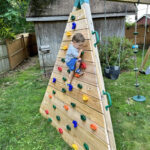Light-colored igneous rocks differ significantly from their darker counterparts primarily due to their mineral composition, which influences their silica content and overall density; rockscapes.net can guide you through understanding these differences and how they impact landscape design. Felsic and mafic are the two main categories that define this distinction, influencing everything from the rock’s appearance to its durability, and the applications for granite, basalt, and more, are well suited for any project.
1. Understanding Igneous Rock Classification
Igneous rocks are categorized based on two primary characteristics: texture and composition. Texture refers to the physical characteristics of the minerals, like grain size, which indicates the cooling history of the molten magma. Composition relates to the mineralogy and chemical makeup. Both factors provide insight into how these rocks form and where they might be best used in your landscape.
1.1. Texture in Igneous Rocks
Texture describes the size, shape, and arrangement of mineral grains within a rock. This is largely determined by the cooling rate of the magma or lava from which the rock formed.
-
Phaneritic: This coarse-grained texture occurs when magma cools slowly deep within the Earth’s crust, allowing large crystals to grow. You can easily see individual crystals with the naked eye. Granite, a classic intrusive igneous rock, exhibits this texture.
-
Aphanitic: Fine-grained texture results from rapid cooling of lava on the Earth’s surface or in shallow fissures. The crystals are too small to be seen without a microscope. Basalt, a common extrusive igneous rock, displays this texture.
-
Porphyritic: This mixed texture features large crystals (phenocrysts) in a fine-grained matrix (groundmass). It indicates a multi-stage cooling history, where the magma cooled slowly at depth and then more quickly near the surface.
-
Pegmatitic: This very coarse-grained texture is found in veins or masses formed from residual molten material. It contains exceptionally large crystals of minerals like feldspar and quartz, indicating extremely slow crystallization.
-
Vesicular: This texture contains gas bubbles trapped in solidifying lava, creating holes called vesicles. Scoria, a type of volcanic rock, commonly exhibits vesicular texture.
-
Volcanic Glass: This non-crystalline texture occurs when lava cools so rapidly that crystals don’t form. Obsidian is a prime example, displaying a glassy appearance and conchoidal fracture.
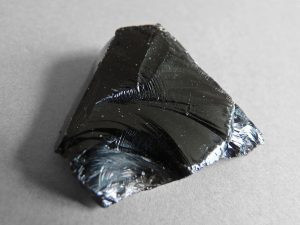 Volcanic glass, obsidian, with conchoidal fracture due to rapid cooling
Volcanic glass, obsidian, with conchoidal fracture due to rapid cooling -
Pyroclastic: This texture results from explosive volcanic eruptions that throw lava, rock, ash, and gases into the atmosphere. The solid parts, called tephra, settle and cool into rocks with a chaotic mix of crystals, glass shards, and rock fragments. Tuff is a rock formed from large deposits of tephra fragments.
1.2. Composition of Igneous Rocks
The composition of igneous rocks is divided into four main groups based on the amounts of silica, iron, and magnesium: felsic, intermediate, mafic, and ultramafic.
- Felsic: These rocks are predominantly composed of light-colored minerals like feldspar and silica (quartz). They are rich in silica (65-75% SiO2) and poor in iron and magnesium.
- Intermediate: These rocks have a composition between felsic and mafic, containing roughly equal amounts of light and dark minerals, such as plagioclase feldspar and amphibole. They have a silica content in the 55-60% range.
- Mafic: These rocks are abundant in ferromagnesian minerals (rich in magnesium and iron) and plagioclase feldspar. They are mostly made of dark minerals like pyroxene and olivine and are relatively poor in silica (45-50% range).
- Ultramafic: These rocks are extremely mafic, composed mostly of olivine and pyroxene. They have even more magnesium and iron and even less silica (40% or less).
2. Key Differences: Light vs. Dark Igneous Rocks
The distinction between light-colored and dark-colored igneous rocks hinges on their mineral composition and silica content.
2.1. Mineral Composition
- Light-Colored Rocks (Felsic): Dominated by minerals such as quartz, feldspar (orthoclase, plagioclase), and muscovite. These minerals are high in silica and aluminum, giving the rocks their light coloration.
- Dark-Colored Rocks (Mafic & Ultramafic): Rich in minerals like olivine, pyroxene, amphibole, and biotite. These minerals contain more iron and magnesium, resulting in a darker appearance.
2.2. Silica Content
- Light-Colored Rocks (Felsic): High silica content (65-75%). This high silica content contributes to their lower density and lighter color.
- Dark-Colored Rocks (Mafic & Ultramafic): Low silica content (45-50% for mafic, <40% for ultramafic). Their lower silica content and higher iron and magnesium levels make them denser and darker.
2.3. Density
- Light-Colored Rocks (Felsic): Lower density due to the prevalence of lighter minerals like quartz and feldspar.
- Dark-Colored Rocks (Mafic & Ultramafic): Higher density due to the presence of heavier minerals like olivine and pyroxene.
2.4. Formation Environment
- Light-Colored Rocks (Felsic): Typically formed from continental crust material, which is richer in silica and aluminum.
- Dark-Colored Rocks (Mafic & Ultramafic): Commonly formed from oceanic crust or upper mantle material, which is richer in iron and magnesium.
2.5. Common Examples
-
Light-Colored Rocks (Felsic): Granite and rhyolite are classic examples. Granite is an intrusive rock with a coarse-grained texture, while rhyolite is its extrusive equivalent with a fine-grained texture.
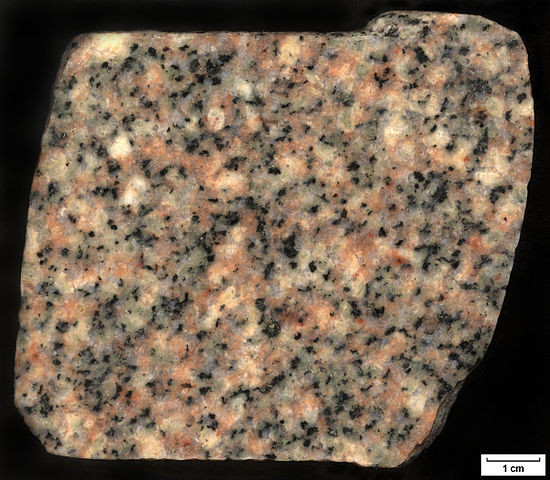 Granite rock with salmon pink potassium feldspar and white plagioclase crystals
Granite rock with salmon pink potassium feldspar and white plagioclase crystals -
Dark-Colored Rocks (Mafic): Basalt and gabbro are common mafic rocks. Basalt is an extrusive rock with a fine-grained texture, often found in oceanic crust. Gabbro is its intrusive equivalent, with a coarse-grained texture.
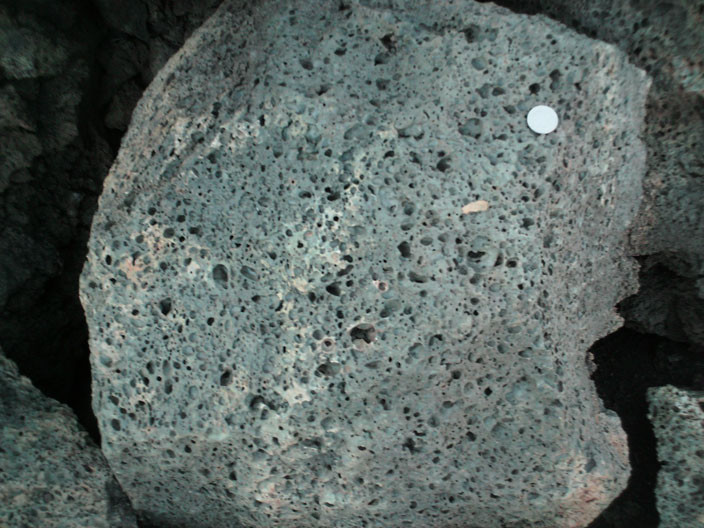 Vesicular basalt rock with bubbles formed during cooling
Vesicular basalt rock with bubbles formed during cooling
3. Detailed Examination of Felsic and Mafic Rocks
To further understand the differences, let’s examine specific examples of felsic and mafic rocks and their properties.
3.1. Felsic Rocks: Granite and Rhyolite
Granite and rhyolite are both felsic rocks, meaning they are rich in silica and light-colored minerals. Granite is intrusive, forming deep within the Earth, while rhyolite is extrusive, forming on the surface from lava.
| Characteristic | Granite | Rhyolite |
|---|---|---|
| Texture | Coarse-grained (phaneritic), with easily visible crystals. | Fine-grained (aphanitic), with crystals too small to see without magnification. |
| Mineral Content | Predominantly quartz, potassium feldspar, and plagioclase feldspar. May also contain small amounts of biotite mica and amphibole. | Similar to granite, but with a higher proportion of glassy quartz phenocrysts. |
| Color | Typically light-colored, ranging from pink to white to gray, depending on the specific mineral composition. | Commonly pink or light gray. |
| Formation | Forms from slow cooling of magma deep beneath the Earth’s surface. | Forms from rapid cooling of lava on the Earth’s surface. |
| Uses | Widely used in construction, monuments, countertops, and landscaping due to its durability and aesthetic appeal. | Less common than granite due to the lower mobility of felsic lavas. Used in some construction and landscaping applications. |
| Notable Examples | Yosemite National Park’s granite formations; Stone Mountain, Georgia. | Yellowstone National Park lava flows; Grand Canyon of the Yellowstone’s altered rhyolite. |
3.2. Mafic Rocks: Basalt and Gabbro
Basalt and gabbro are mafic rocks, meaning they are rich in iron and magnesium and dark in color. Basalt is extrusive, forming from lava on the surface, while gabbro is intrusive, forming deep within the Earth.
| Characteristic | Basalt | Gabbro |
|---|---|---|
| Texture | Fine-grained (aphanitic), often vesicular due to trapped gases. | Coarse-grained (phaneritic), with visible crystals. |
| Mineral Content | Primarily pyroxene and plagioclase feldspar, with possible olivine phenocrysts. | Mainly mafic minerals like pyroxene and minor plagioclase. |
| Color | Typically dark gray to black. | Dark-colored, usually dark green or black. |
| Formation | Forms from rapid cooling of lava on the Earth’s surface, commonly at mid-ocean ridges and volcanic hotspots. | Forms from slow cooling of magma deep beneath the Earth’s surface, often in the lower oceanic crust. |
| Uses | Commonly used in construction, road paving, and as a base material. Vesicular basalt (scoria) is used in landscaping for drainage and decoration. | Used in construction, especially for paving stones and building facings. |
| Notable Examples | Hawaiian lava flows; Giant’s Causeway in Northern Ireland. | Oceanic crust; Bushveld Igneous Complex in South Africa. |
4. Applications in Landscaping
Understanding the differences between light and dark-colored igneous rocks is crucial for effective landscape design.
4.1. Aesthetic Considerations
- Color Contrast: Use light and dark rocks to create visual contrast and highlight specific areas of your landscape. For example, light-colored granite can be used as a pathway against a backdrop of dark basalt boulders.
- Texture Variation: Combine rocks with different textures to add depth and interest. Smooth river stones can complement the rough surface of a scoria rock garden.
- Themed Gardens: Create specific garden themes based on rock color and type. A Mediterranean garden might feature light-colored limestone and granite, while a volcanic garden could showcase dark basalt and scoria.
4.2. Functional Applications
- Pathways and Walkways: Granite and basalt are durable choices for pathways. Granite provides a lighter, more reflective surface, while basalt offers a darker, more natural look.
- Retaining Walls: Large boulders of granite or basalt can be used to create sturdy and visually appealing retaining walls. Their density and strength make them ideal for this purpose.
- Drainage: Vesicular basalt (scoria) is excellent for improving soil drainage in garden beds and planters. Its porous nature allows water to flow freely.
- Rock Gardens: Combine various types of igneous rocks to create unique rock gardens. Consider the specific mineral compositions and how they might affect plant growth.
4.3. Design Tips
- Consider the Local Environment: Choose rocks that complement the natural surroundings. In desert landscapes, light-colored rocks can reflect heat and reduce water evaporation. In wetter climates, darker rocks can retain heat and promote plant growth.
- Incorporate Native Rocks: Using locally sourced rocks can create a more natural and cohesive look. It also reduces transportation costs and supports local economies.
- Plan for Long-Term Maintenance: Understand the weathering properties of different rocks. Some rocks may fade or change color over time, while others may be more resistant to erosion.
5. Igneous Rock Bodies
Igneous rocks form various structures within the Earth, which are important for understanding their origin and distribution.
5.1. Intrusive Bodies
Intrusive bodies are formed when magma cools and solidifies beneath the Earth’s surface.
-
Dikes: These are discordant intrusions that cut across existing rock layers. They are often vertical or at an angle and are useful for dating rock sequences.
-
Sills: These are concordant intrusions that run parallel to the surrounding sedimentary layers. They form when magma exploits weaknesses between layers.
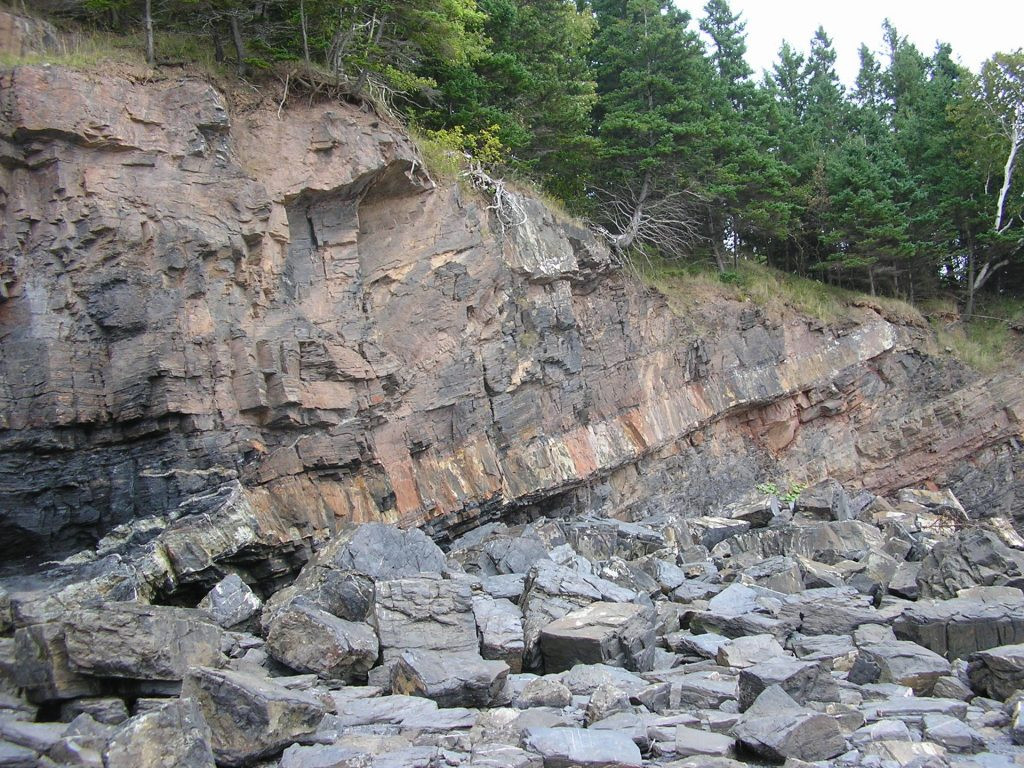 Igneous sill intruding between Paleozoic strata
Igneous sill intruding between Paleozoic strata -
Plutons: These are masses of intrusive rock formed from cooled magma chambers. When many plutons merge, they form a batholith.
-
Batholiths: These are large, extensive features found in the cores of mountain ranges, often associated with subduction zones.
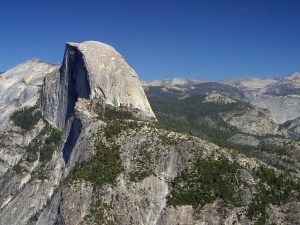 Half Dome at Yosemite National Park, part of the Sierra Nevada batholith
Half Dome at Yosemite National Park, part of the Sierra Nevada batholith -
Stocks: These are smaller plutons with less surface exposure than batholiths.
-
Laccoliths: These are blister-like intrusions that form between sedimentary layers, causing the overlying layers to bulge upwards.
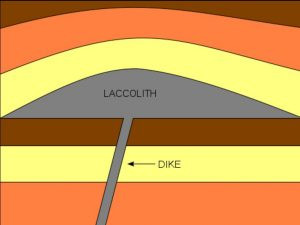 Diagram showing formation of laccolith between sedimentary layers
Diagram showing formation of laccolith between sedimentary layers
5.2. Extrusive Bodies
Extrusive bodies are formed when lava cools and solidifies on the Earth’s surface.
- Lava Flows: These are sheets of solidified lava that can cover large areas.
- Volcanic Cones: These are cone-shaped structures formed by repeated eruptions of lava and tephra.
- Pyroclastic Deposits: These are accumulations of tephra fragments from explosive volcanic eruptions.
6. The Role of Igneous Rocks in Soil Formation
Igneous rocks play a significant role in soil formation through weathering processes.
6.1. Weathering Processes
- Physical Weathering: This involves the breakdown of rocks into smaller pieces without changing their chemical composition. Processes include freeze-thaw cycles, abrasion, and exfoliation.
- Chemical Weathering: This involves the alteration of rock minerals through chemical reactions. Processes include oxidation, hydrolysis, and dissolution.
6.2. Impact on Soil Properties
- Mineral Composition: The mineral composition of the parent rock (igneous rock) influences the mineral content of the soil. For example, mafic rocks contribute iron and magnesium to the soil, while felsic rocks contribute silica and aluminum.
- Texture: The texture of the parent rock influences the texture of the soil. Coarse-grained rocks produce sandy soils, while fine-grained rocks produce clayey soils.
- Nutrient Availability: Weathering of igneous rocks releases essential nutrients for plant growth, such as potassium, calcium, and magnesium.
7. Case Studies: Successful Landscape Designs Using Igneous Rocks
Here are a few case studies that highlight successful landscape designs using igneous rocks:
7.1. Desert Landscape in Arizona
- Objective: Create a low-maintenance, water-efficient landscape that blends with the natural desert environment.
- Materials: Locally sourced granite boulders, basalt gravel, and native desert plants.
- Design: Large granite boulders were strategically placed to create focal points and provide shade. Basalt gravel was used as a mulch to suppress weeds and conserve moisture. Native desert plants were selected for their drought tolerance and aesthetic appeal.
- Result: A beautiful and sustainable landscape that requires minimal watering and maintenance.
7.2. Mountain Retreat in Colorado
- Objective: Design a landscape that complements the rugged mountain terrain and provides outdoor living spaces.
- Materials: Locally quarried granite andesite, flagstone, and river stones.
- Design: Granite andesite boulders were used to create retaining walls and terraces. Flagstone pathways and patios provided comfortable walking surfaces. River stones were used to create dry creek beds and water features.
- Result: A functional and aesthetically pleasing landscape that seamlessly integrates with the natural environment.
7.3. Coastal Garden in California
- Objective: Create a coastal garden that is both beautiful and resistant to salt spray and erosion.
- Materials: Basalt boulders, sea shells, and salt-tolerant plants.
- Design: Basalt boulders were used to create a protective barrier against wind and waves. Sea shells were incorporated into the garden beds to improve drainage and add a unique aesthetic element. Salt-tolerant plants were selected for their ability to thrive in the harsh coastal environment.
- Result: A resilient and visually stunning garden that enhances the coastal property.
8. Future Trends in Igneous Rock Landscaping
Several emerging trends are shaping the future of igneous rock landscaping.
8.1. Sustainable Sourcing
- Local Quarries: Increasing emphasis on sourcing rocks from local quarries to reduce transportation costs and environmental impact.
- Recycled Materials: Use of recycled concrete and asphalt as alternatives to natural stone.
- Permeable Paving: Adoption of permeable paving materials made from crushed igneous rock to improve stormwater management.
8.2. Innovative Design Techniques
- Xeriscaping: Growing popularity of xeriscaping, a water-wise landscaping technique that utilizes drought-tolerant plants and rocks.
- Vertical Gardens: Incorporation of igneous rocks into vertical garden designs to create unique and eye-catching features.
- 3D Printing: Experimentation with 3D printing technology to create custom rock formations and landscape elements.
8.3. Technological Advancements
- Drone Surveys: Use of drones to survey landscapes and create detailed maps for rock placement and design planning.
- Augmented Reality: Application of augmented reality (AR) to visualize landscape designs and experiment with different rock arrangements.
- Smart Irrigation Systems: Integration of smart irrigation systems to optimize water usage and promote plant health in rock gardens.
9. FAQ About Light-Colored and Dark-Colored Igneous Rocks
Here are some frequently asked questions about the differences between light-colored and dark-colored igneous rocks, designed to help you make informed decisions for your landscaping projects.
9.1. What causes the color difference in igneous rocks?
The color difference is primarily due to the mineral composition; light-colored rocks are rich in silica, aluminum, and minerals like quartz and feldspar, whereas dark-colored rocks contain more iron and magnesium.
9.2. How does silica content affect the properties of igneous rocks?
Higher silica content in light-colored rocks leads to lower density and lighter color, while lower silica content in dark-colored rocks results in higher density and darker appearance.
9.3. Which type of igneous rock is more durable for landscaping?
Both light and dark igneous rocks can be durable, but it depends on the specific rock and its environment. Granite and basalt are commonly used due to their strength and resistance to weathering.
9.4. Can I use both light and dark igneous rocks in the same landscape design?
Absolutely; combining light and dark rocks can create visual contrast and add depth to your landscape design, enhancing its overall aesthetic appeal.
9.5. Are light-colored rocks better for hot climates?
Light-colored rocks reflect more sunlight, which can help reduce heat absorption in hot climates, making them a good choice for desert landscapes.
9.6. Do dark-colored rocks retain more heat?
Yes, dark-colored rocks absorb more heat, which can be beneficial in cooler climates for promoting plant growth and extending the growing season.
9.7. How do I identify different types of igneous rocks?
Identifying igneous rocks involves examining their color, texture, and mineral composition, which can be done with a magnifying glass or through geological testing. Rockscapes.net offers guides and resources to help with identification.
9.8. What are the best igneous rocks for retaining walls?
Large boulders of granite or basalt are ideal for retaining walls due to their density, strength, and aesthetic appeal, providing both functionality and visual interest.
9.9. How does the texture of igneous rock affect its use in landscaping?
Coarse-grained rocks like granite can provide a rugged, natural look, while fine-grained rocks like basalt can offer a smoother, more contemporary appearance, depending on your design preferences.
9.10. Where can I source high-quality igneous rocks for my landscaping project?
Rockscapes.net provides a directory of trusted suppliers and local quarries where you can source a variety of high-quality igneous rocks for your landscaping needs.
10. Unleash the Beauty of Igneous Rocks with Rockscapes.net
Ready to transform your outdoor space with the enduring beauty of igneous rocks? Rockscapes.net is your ultimate resource for inspiration, information, and expert guidance. Discover stunning design ideas, detailed guides on selecting the perfect rocks, and practical tips for installation and maintenance.
Don’t wait to create the landscape of your dreams. Visit Rockscapes.net today to explore our extensive collection of igneous rock resources and connect with landscape design professionals who can bring your vision to life.
Address: 1151 S Forest Ave, Tempe, AZ 85281, United States
Phone: +1 (480) 965-9011
Website: rockscapes.net
Unlock the potential of your landscape with rockscapes.net, where beauty meets expertise.
